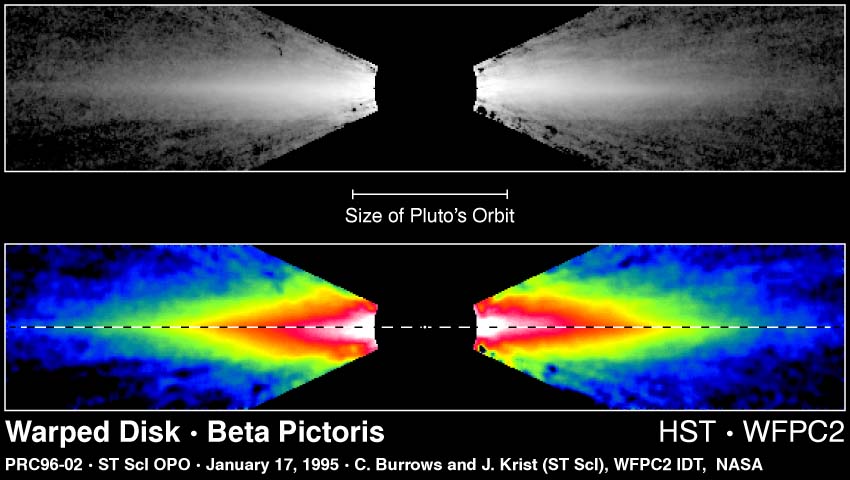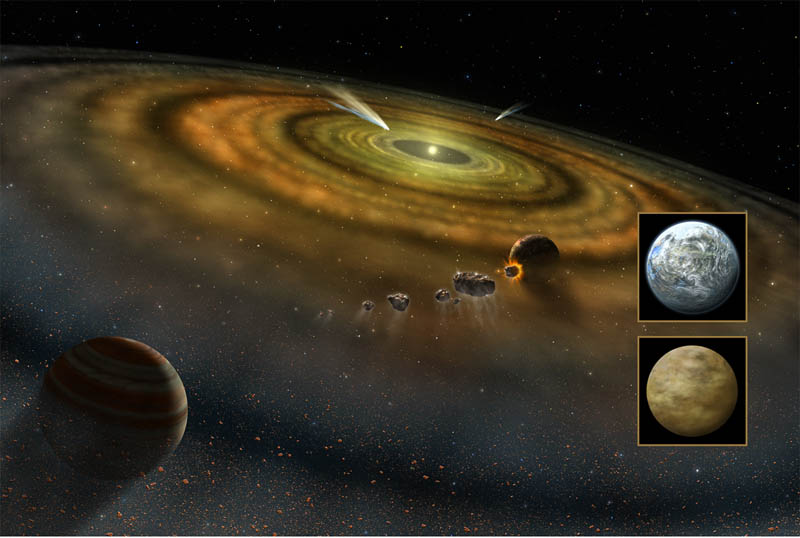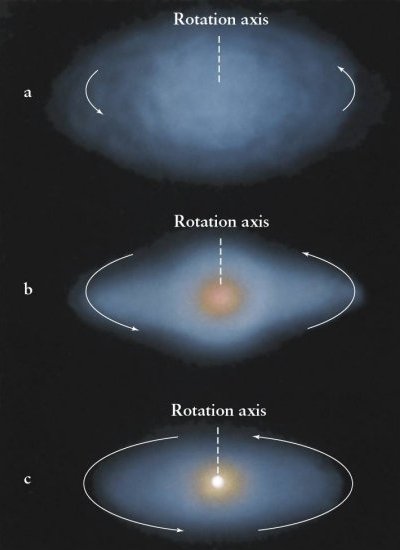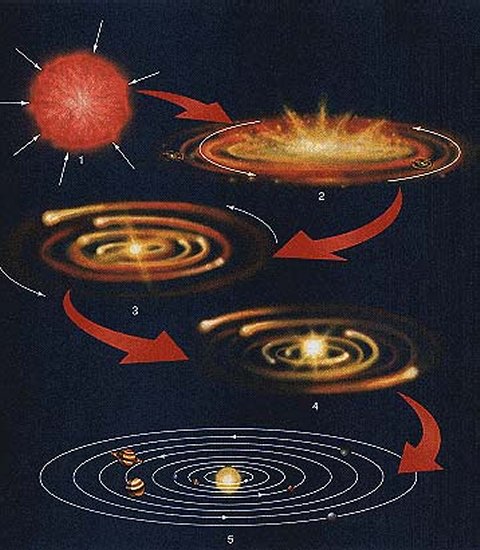

|
Part 4A:
FORMATION OF THE SOLAR SYSTEM
Reading:
Formation of the Solar System, Chapter 6
|
Reminder:
Any successful theory for the formation of the Solar System
must explain (i) the
dynamical regularities of the planets and (ii) the existence and
properties of the three
distinct classes of planets,
the Terrestrial, Jovian, and Rocky/Ice planets (and other Solar System debris).
SOLAR SYSTEM FORMATION: NEBULAR THEORY
The basic idea for our current model for the formation of the Solar System,
the Nebular Theory,
has a long history. The original ideas were first presented by Immanuel Kant
(1755). Later, Pierre Laplace (1796) modified the model, From a slightly
modified description from our friend Google,
"The Nebular hypothesis is the idea that a spinning cloud of dust and gas
made of mostly light elements (hydrogen and helum)
called a nebula, flattened into a protoplanetary
disk, and became a Solar System consisting of a star with orbiting planets"
Here we discuss our modern version of the Nebular Theory
paying particular attention to how it explains the dynamical regularities
and the existence of three types of planets in our Solar System.
| |
Collapse of a Rotating Interstellar Medium Cloud
Explains the Dynamical Regularities of our Solar System
Star formation in our Galaxy occurs in Interstellar clouds known as
Giant Molecular Clouds (see
Topic 7: Star Formation in
ASTR 122).
The Solar System formed around 4.5 billion years ago from a
cold, rotating clump inside a GMC.
The initial cloud was several light years across and
composed of atoms with composition: 90 %
hydrogen, 9 %
helium with small amounts of everyting else
(like iron, carbon,
oxygen, ...). This large swirling cloud
eventually forms what is referred to as the
Solar Nebula, the cloud from which our
Solar System formed.
To begin the process, around 4.5 billion years ago, an event
triggered the slowly spinning cloud to
start to collapse. As the cloud constracted,
it started to spin faster to conserve the quantity known as
angular momentum.
Angular momentum is a measure of the spin
momentum of the cloud.
(To see another example of this, look at the YouTube video showing
ice skaters executing spins, start around
0:44).
As the cloud spun faster,
it flattened because of the centrifugal force.
The Solar Nebula is now a flattened disk ready to form the Sun and the
planets.
The simple idea that a rotating, contracting cloud spins-up
as it shrinks, and flattens into a disk forming the Solar Nebula
leads to a natural explanation for most of the important dynamical
regularities of the planets. Namely, (i) orbits that are in the same
sense, (ii) orbits that are roughly coplaner, (iii) rotations of the
planets that are usually in the same sense as the orbital motions,
and (iv) orbits
of moons are in the same sense as the planet's orbits.
Circularization of the orbits occurs later but it is not a stretch
to note that it will naturally follow from our models of how planets
form in the rotating gaseous disk of the Solar Nebula.
|
Schematically, the process goes as follows:

|
Planet Formation and the Terrestrials, the Jovians, and
the Rock/Ice Objects
After the initial contraction phase of Solar System formation,
the Solar Nebula is a flattened rotating disk made
of gas and dust. The gas is the bulk of the
nebula, primarily composed of
hydrogen and helium.
The dust is made of heavier elements and materials
(silicates, iron, carbon, ...). The hydrogen and helium make up
98 % of the mass of the Solar Nebula, the dust making up the other part.
The Sun forms at the center of the nebula while the
planets form through what is called the
core accretion scenario
in the midplane of the Solar Nebula
. The initial phases of planet formation involve the solid
dust particles colliding and coaslescing.
Because it never becomes cold enough in the
Solar Nebula for hydrogen and helium to freeze,
they always remain gaseous and so don't participate in
the collision and coalescence phase of planet formation.
We describe the core-accretion scenario in a little more detail below:
- small dust grains (~10-5 meter in size) embedded in the
cloud collide and coalesce. This process of collision and
coalescence continues until the clumps are large enough to be held
together by gravity; this occurs when they are a few kilometers
across. At this time the objects are referred to as
planetesimals.
- When the gravity of the planetesimals becomes large enough to start
attracting other
planetesimals
and so to form larger bodies, they are referred
to as protoplanets.
Protoplanets
have sizes in the range 100 km to thousands of kilometers.
- The larger protoplanets (after reaching a critical size)
may then grab and hold
onto the hydrogen and helium gas in the cooler,
outer regions of the Solar Nebula.
These objects become the Jovian planets. In the hot inner
regions of the Solar Nebula, protoplanets
are unable to capture hydrogen and helium
gas. These objects eventually become the Terresrial planets.
The above process is slow,
taking 3 to 10 Million years to form Jovian planets.
|

|
Comment--Roughly around the time the larger protoplanets captured
hydrogen and helium gas, the Sun ignited nuclear fusion in its core
becoming a star and generated a strong outflow of material
(an extreme Solar Wind).
The Sun entered the
T Tauri stage.
The strong wind cleared the gas from the Solar Nebula
and arrested the Jovian planet
formation. For our Solar System this happened shortly after Jupiter and
Saturn formed, the Solar Nebula lost its hydrogen and helium
gas 3-4 million years or so
after Jupiter and Saturn formed. This close timing is a little worrisome.
The wind does not clear out solid material, however. The
left-over pieces of rocks and rock/ice are the rock/ice objects and the
material left-over in the Asteroid Belt and Kuiper Belt. Large chunks
of solid debris can also
have a substantial impact on the evolution of
the young planets as well as eventually forming the Terrestrial planets
which takes hundreds of millions more years.
Some pictures of planet forming disks are
shown below:
 HL Tau (ALMA observatory) HL Tau (ALMA observatory) |
 PDS 70 (Subaru telescope) PDS 70 (Subaru telescope) |
The Nebular Theory (described above) leads to solid
explanations for the orbital and other dynamical regularties, and for the
existence of three types of objects, the Terrestrials, the Jovians, and the
Rock/Ice objects. It does a nice job.
A closer look at the NEBULAR THEORY offers
details about the 3 distinct classes
of planets, the
Terrestrials, Jovians, and rocky/icy planets and how
they came about. These details are important because they make
predictions that can be checked when we look at
extra-Solar planetary systems.
As described above, the general existence of the Terrestrial
and Jovian planets is a natural by-product of
the planet formation process. The details of the process bring out
the following things:
- Snowline.
Let's discuss a detail of the model that explains why the
Jovians form where they do in the Solar System and so makes a strong
prediction about a general feature we might expect to find in extra-Solar
planetary systems.

As you move outward in the Solar Nebula,
the disk gets cooler and although hydrogen and helium will never freeze,
simple molecules that contain hydrogen
such as water, H2O, methane, CH4,
and ammonia,
NH3, may freeze
forming ice coatings around the dust particles.
The radius beyond which ice forms in the Solar Nebula is called
the Snowline.
Outside of hydrogen and helium, carbon, nitrogen, and oxygen are
among the most abundant elements
in the Solar Nebula (and indeed in the Universe).
Consequently,
a relatively large amount of ice forms which geatly enhances the
amount of solid material available to form planets.
This leads to faster planetesimal
formation and to more massive planetesimals.
This in term leads to the formation of more massive
protoplanetary cores.
Outside of the Snowline,
because the protoplanetary cores are more massive, they have stronger
gravitational fields. This allows them to more easily capture
large amounts of the plentiful hydrogen and helium gas and so to
grow massive. The Snowline
marks the boundary between the regions
where Terrestrial planets form and where Jovian planets form,
and where we expect to start finding rock/ice objects.
In our Solar System, the
Snowline falls around 3-4 Astronomical
Units. The Jovian planets, as expected, indeed fall outside of the
Snowline as do the asteroids, dwarf
planets and Kuiper Belt.
This crucial boundary is expected to show
up in extra-Solar planetary systems as well if our understanding of
Solar System formation is correct. (What do we make
of Hot Jupiters?)
- Are there thoughts as to
why the Jovian planets appear to divide
into two groups, Jupiter
and Saturn versus Uranus and Neptune? Perhaps, let's review a bit.
Jupiter forms just beyond the Snowline where the
concentration of materials is likely to be highest.
Because of this, Jupiter was able to form a
giant rock/ice core (14-18 times the mass of the Earth). This
extra-large core gave Jupiter a larger gravitational pull which then
allowed Jupiter to capture and then hold onto large amounts of
hydrogen and helium gas. Saturn also followed this route amassing
a rock/ice core 17 times the mass of the Earth.
- Uranus and Neptune also started down this path but perhaps more
slowly than did Jupiter and Saturn because they were further out in the
Solar Nebula where things were more spread out and moved around
more slowly. For whatever reason,
it seems that before Uranus and Neptune
could finish the job of formation, something happened.
Perhaps
the Sun turned on and blew out the
gaseous material from the Solar Nebula and
stunted their growth, or maybe, migration played
a role.
- The ideas about how Uranus and
Neptune form may benefit greatly from our current
observations of extra-Solar planetary systems.
The exact manner
in which Uranus and Neptune form is still not clear.
Vexing Features, Earth-Moon System, rotations of Uranus
and Neptune, tell us about how the Solar System evolved after its
intial formation
The Earth-Moon system is unusual, it is more a binary planet system
than a planet and a moon system. There is only one other example of this in
our Solar System, the Pluto-Charon system. For all of the other moon systems
the moons are much smaller in comparison to their parent planets than are
the Moon and the Earth and Charon and Pluto.
This leads to interesting scenarios for the Moon's formation.
We envision that Theia,
a Mars-sized asteroid, struck the young Earth
dealing a glancing blow which knocked material off of the Earth.
The ejected material formed a debris ring around the Earth from which
the Moon formed. The collision may have also caused
the Earth's rotation axis to tilt 23.5o with respect
to its orbital axis (for its motion about the Sun). For further
information see
Origin of the Moon. A similar scenario may explain how Uranus's rotation
axis was tipped 98o with respect to its orbital axis.
Astronomers speculate that 3 to 4 billion years ago an object with, perhaps,
twice the mass of the Earth, collided with Uranus and in the ensuing aftermath
of the collision, Uranus wound up with its unusual rotation.











